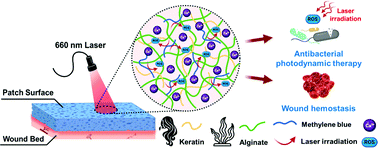A hemostatic keratin/alginate hydrogel scaffold with methylene blue mediated antimicrobial photodynamic therapy†
Abstract
Uncontrollable bleeding and infection are two of the most common causes of trauma-related death. Yet, developing safe materials with high hemostatic and antibacterial effectiveness remains a challenge. Keratin-based biomaterials have been reported to exhibit the functions of enhancing platelet binding and activating and facilitating fibrinogen polymerization. In this study, we designed a hemostatic material with good biodegradability, biocompatibility, hemostatic ability, and antibacterial function to solve the shortcomings of common hemostatic materials. Methylene blue-loaded keratin/alginate composite scaffolds were prepared by the freeze-gelation method. The composite scaffolds exhibited over 1600% liquid absorption, well-interconnected pores, good biocompatibility, and biodegradability. We find that the keratin/alginate composite scaffolds' synergistic action may significantly reduce hemostasis time. To prevent infection, the drug-loaded scaffolds generated high burst release by absorbing wound exudate in the early stages of wound healing. The results obtained by the antimicrobial photoinactivation assay in vitro suggest that an antimicrobial photodynamic effect might be triggered, thereby preventing the fast growth of colonies.



 Please wait while we load your content...
Please wait while we load your content...